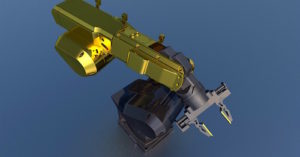Composite 3D printing allows designers, engineers, and manufacturers to easily create strong, high-quality 3D printed parts at a lower cost than traditional manufacturing methods. The Mark Two composite 3D printer from Markforged provides users with a range of benefits including:
- Strong parts: The technology that supports composite 3D printing creates parts that have unparalleled strength, stiffness, and durability.
- Variety of materials: Create composite parts using onyx, carbon fiber, fiberglass, or Kevlar.
- Easy-to-use: The included Eiger software was created specifically for the Markforged printing system– making extremely intuitive for all users.
Using the Mark Two for composite 3D printing allows designers, engineers, and manufacturers to create strong, high-quality parts at a fraction of the cost of traditional manufacturing methods.
Composite 3D Printing
Why use composite 3D printing over other 3D printing methods?
Carbon fiber reinforcement is not a new concept. This technology has been utilized in many industries including sporting goods, aerospace, automotive, and renewable energy. Unfortunately, traditional manufacturing for carbon fiber reinforced plastics can be complicated, which often results in expensive manufacturing processes.
Composite 3D printing opens up a world of possibilities for carbon reinforced parts. Compared to traditional manufacturing techniques, carbon reinforced 3D printing is simple and straightforward.
Composite 3D printing prints parts that can be up to five times stronger than steel, twenty times stiffer, and up to thirty percent lighter. Increased strength with decreased weight allows composite 3D printing to be used for an even broader range of parts and industries. In particular, composite 3D printing is ideal for parts that are subject to stress or other adverse conditions.
Composite 3D printing can create parts that are:
5x stronger than steel
20x stiffer
30% lighter
Continuous filament vs chopped fibers
Composite 3D printing from Markforged offers the choice of either continuous filament or chopped (discontinuous) fibers. Both filament options provide users with increased strength and stiffness in their parts.
The Mark Two: Advanced Composite 3D Printing
The Mark Two is an advanced printer that can print composite parts, but thanks to dual printer heads, can also print non-composite parts in a range of materials including carbon fiber, fiberglass, Kevlar, or Onyx (a proprietary chopped fiber material from Markforged).
Eiger software
All Markforged printers come with Eiger software. This cloud-based software can run within any web browser and imports standard 3D CAD files from whichever CAD program you use.
Once drawings are imported, the Eiger software analyzes part components to determine the best reinforcement points. It can then select the best fiber routing and slicing options for optimal strength and flexibility.
Eiger software analyzes and optimizes the print design to determine the best reinforcement points and slicing options for increased strength and flexibility.
Eiger eliminates many of the complicated calculations that are usually required when going from CAD to 3D printed part. Although engineers always have the option to manually take control of these print pattern design aspects, many find that Eiger‘s automatic calculations actually provides the best analysis and solution.
Fit and finish
The Mark Two prints at a resolution of 100 microns, providing users with a beautiful finish right off of the printer without any additional polishing. The printer also uses a snap-in print bed that can be removed for cleaning or to add additional components. Once completed, the user can then snap the bed back in within a 10-micron tolerance.
These specifications eliminate the need for expensive post-processing, which can significantly reduce production costs compared to traditional manufacturing methods.
With a print resolution of 100-microns, the Mark Two produces parts with a beautiful finish right off the printer.
Why use the Mark Two for composite 3D printing?
The Mark Two can lay down composite materials at much smaller volumes than other composite 3d printers. These capabilities allow users to design stronger and lighter parts with very high tolerances. The Mark Two also prints 40% faster than previous Markforged models allowing you to print parts in a matter of hours.
The Mark Two 3D printer prints 40% faster than previous Markforged models.
The Mark Two also comes equipped with an intuitive touch screen panel that makes it easy for users to operate and control. Wi-Fi connections also allow users to start and stop prints from the touch screen or from another room using a control panel in the Eiger software.
The speed, flexibility, and tolerances available on the Mark Two, coupled with easy to use software and touchscreen interface make this an ideal printer for all of your composite 3D printing needs.
Success Stories: Using the Mark Two for Composite 3D Printing
Arrow Global: Prototyping
 Arrow Global, a company that specializes in transportation window systems, needed a way to cost-effectively expand their prototyping capabilities. Specifically, they needed to generate prototypes for rubber extrusions used in coaches and buses. Traditionally, prototyping rubber parts is cost prohibitive and regularly machined aluminum couldn’t stand up to testing, which is required to ensure that parts will withstand the stresses of the real world.
Arrow Global, a company that specializes in transportation window systems, needed a way to cost-effectively expand their prototyping capabilities. Specifically, they needed to generate prototypes for rubber extrusions used in coaches and buses. Traditionally, prototyping rubber parts is cost prohibitive and regularly machined aluminum couldn’t stand up to testing, which is required to ensure that parts will withstand the stresses of the real world.
Arrow Global began utilizing the Mark Two to create prototypes for testing and then started using its capabilities to create custom jigs for production. Using the Mark Two significantly reduced production costs and time from $400 and at least two weeks to a $1.50 and less than a day.
Using the Mark Two allowed Arrow Global to reduce the cost and prototyping time from $400 and two weeks all the way down to $1.50 and less than a day.
Shift Koncepts: Automotive Racing
Shift Koncepts designs and manufactures high-end paddle shifters for the automotive racing aftermarket. The founder, Hung Ngo, races in his free time. He discovered the need for custom elongated paddle shifters after spending months searching for them online and not finding anything. In an effort to come up with a solution, Hung originally had some paddle shifters 3D printed using PLA, but the shifters looked cheap and turned out to be too flimsy for actual use.
Hung Ngo started Shift Koncepts after recognizing the need for strong, high- end extended paddle shifters.
After seeing a Markforged printer in a local manufacturing shop, Hung jumped on the opportunity to create his own extended paddle shifters and ended up starting Shift Koncepts in January of 2016. They started with the Mark One but later upgraded to the Mark Two due to its increased ability to create strong and stiff parts with a beautiful finish on end products.
Dixon Valve and Coupling: Custom Robotic Arms
 Dixon Valve and Coupling is a manufacturer and supplier of hose fittings and accessories. They use custom robotic arms to manufacture their hoses and other accessories. Creating custom jaws for the robotic arms on the shop floor using traditional CNC manufacturing was expensive and time-consuming at $300 and 72-hours plus shipping time. In contrast, the company found that utilizing the Markforged Mark Two was an extremely cost-effective solution, allowing them to produce their custom robot jigs heads at $10 a piece in just under 10 hours.
Dixon Valve and Coupling is a manufacturer and supplier of hose fittings and accessories. They use custom robotic arms to manufacture their hoses and other accessories. Creating custom jaws for the robotic arms on the shop floor using traditional CNC manufacturing was expensive and time-consuming at $300 and 72-hours plus shipping time. In contrast, the company found that utilizing the Markforged Mark Two was an extremely cost-effective solution, allowing them to produce their custom robot jigs heads at $10 a piece in just under 10 hours.
Composite 3D Printing: Strong, High-Quality Parts
Using the Mark Two for composite 3D printing provides designers, engineers, and manufacturers with the capabilities they need to create great parts.
The Mark Two comes with two printer heads and can print with a range of materials providing additional flexibility compared to other composite 3D printers on the market. Easily print whatever parts you need overnight, directly from CAD drawings, with a beautiful finish and amazing strength.
The Mark Two allows designers to go straight from CAD file to strong, high-quality, 3D printed part in a matter of hours.
Interested in learning more about the Mark Two or any of the other printers from the Markforged lineup? Contact us.